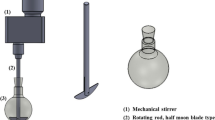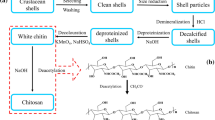Abstract
Sodium alginate and chitosan were cross-linked to form composite gel spheres, which were entrapped to immobilize the free neutral protease. The matrix of the immobilized neutral protease was detected and characterized by using Fourier transform infrared spectroscopy and energy-dispersive X-ray. The optimum immobilization conditions were determined by orthogonal test, in which the concentration of sodium alginate was 3.5%, CaCl2 2.5%, chitosan 2.5%, and immobilizing time 1.5 h. Meanwhile, the activities of immobilized neutral protease and free enzyme were compared. The results showed that the pH value of immobilized enzyme was 5–8, the relative activity was above 90%, the free enzyme was above 80%, the relative activity of immobilized enzyme was above 80% in 30–80 °C, and the free enzyme was above 64% in 40–80 °C. The immobilized enzyme is better than the free enzyme in the constant of pH and temperature. The relative activity of immobilized enzyme was 50% after six hydrolysis cycles, and 80% after 11 days of storage.
Graphical abstract








Similar content being viewed by others
Data Availability
Some or all data, models, or code that support the findings of this study are available from the corresponding author upon reasonable request.
References
Panchagnula, R. (1997). Transdermal delivery of drugs, Indian. Journal of Pharmaceutics, 29, 140–156.
Soppimath, K. S., Aminabhavi, T. M., Kulkarni, A. R., & Rudzinski, W. E. (2001). Biodegradable polymeric nanoparticles as drug delivery devices. Journal of Controlled Release, 70, 1–20.
Shamo, Z. T. (2021). The bonding nature of the chemical interaction between trypsin and chitosan based carriers in immobilization process depend on entrapped method: A review. International Journal of Biological Macromolecules, 183, 1676–1696. https://doi.org/10.1016/j.ijbiomac.2021.05.059
Yingjie, D., Jing, G., Liya, Z., Li, M., Ying, H., Xuefang, Z., Zhihong, H., Yanjun, J. (2019). MOF-based nanotubes to hollow nanospheres through protein-induced soft-templating pathways. Advanced Science, 6(6), 1801684. https://doi.org/10.1002/advs.201801684
Tavares, A. P. M., Silva, C. G., Dražić, G., Silva, A. M. T., Loureiro, J. M., & Faria, J. L. (2015). Laccase immobilization over multi-walled carbon nanotubes: Kinetic, thermo-dynamic and stability studies. Journal of Colloid and Interface Science, 454, 52–60. https://doi.org/10.1016/j.jcis.2015.04.054
Gao, J., Kong, W., Zhou, L., He, Y., Ma, L., Wang, Y., Yin, L., & Jiang, Y. (2017). Monodisperse core-shell magnetic organosilica nanoflowers with radial wrinkle for lipase immobilization. Chemical Engineering Journal, 309, 70–79. https://doi.org/10.1016/j.cej.2016.10.021
Sirisha, V. L., & Jain, A. (2016). Enzyme immobilization: An overview on methods, support material, and applications of immobilized enzymes. Advances in Food and Nutrition Research, 79, 33. https://doi.org/10.1016/bs.afnr.2016.07.004
Ahmed, S. A., Abdella, M. A. A., El-Sherbiny, G. M., Ibrahim, A. M., El-Shamy, A. R. S., Atalla, M. M., & Hassan, M. E. (2020). Catalytic, kinetic and thermal properties of free and immobilized Bacillus subtilis -MK1 α-amylase on chitosan-magnetic nanoparticles. Biotechnology Reports, 26, e00443. https://doi.org/10.1016/j.btre.2020.e00443
Okura, N. S., Sabi, G. J., Crivellenti, M. C., Gomes, R. A. B., Fernandez-Lafuente, R., & Mendes, A. A. (2020). Improved immobilization of lipase from Thermomyces lanuginosus on a new chitosan-based heterofunctional support: Mixed ion exchange plus hydrophobic interactions. International Journal of Biological Macromolecules, 163, 550–561. https://doi.org/10.1016/j.ijbiomac.2020.07.021
Pinheiro, B. B., Rios, N. S., Aguado, E. R., Fernandez-Lafuente, R., Freire, T. M., dos Fechine, P. B. A., Santos, J. C. S., & Gonçalves, L. R. B. (2019). Chitosan activated with divinyl sulfone: A new heterofunctional support for enzyme immobilization, application in the immobilization of lipase B from Candida antarctica. International Journal of Biological Macromolecules, 130, 798–809. https://doi.org/10.1016/j.ijbiomac.2019.02.145
Srivastava, B., Singh, H., Khatri, M., Singh, G., & Arya, S. K. (2020). Immobilization of keratinase on chitosan grafted–β–cyclodextrin for the improvement of the enzyme properties and application of free keratinase in the textile industry. International Journal of Biological Macromolecules, 165, 1099–1110. https://doi.org/10.1016/j.ijbiomac.2020.10.009
Kamaci, U. D., & Peksel, A. (2020). Fabrication of PVA–chitosan–based nanofibers for phytase immobilization to enhance enzymatic activity. International Journal of Biological Macromolecules, 164, 3315–3322. https://doi.org/10.1016/j.ijbiomac.2020.08.226
Nataraj, D., Sakkara, S., Meghwal, M., & Reddy, N. (2018). Crosslinked chitosan films with controllable properties for commercial applications. International Journal of Biological Macromolecules, 120, 1256–1264. https://doi.org/10.1016/j.ijbiomac.2018.08.187
Urrutia, P., Bernal, C., Wilson, L., & Illanes, A. (2018). Use of chitosan heterofunctionality for enzyme immobilization: β–galactosidase immobilization for galacto–oligosaccharide synthesis. International Journal of Biological Macromolecules, 116, 182–193. https://doi.org/10.1016/j.ijbiomac.2018.04.112
Esquerdo, V. M., Cadaval, T. R. S., Jr., Dotto, G. L., & Pinto, L. A. A. (2014). Chitosan scaffold as an alternative adsorbent for the removal of hazardous food dyes from aqueous solutions. Journal of Colloid and Interface Science, 424, 7–15. https://doi.org/10.1016/j.jcis.2014.02.028
Yong, L. K., & David, M. J. (2012). Alginate: Properties and biomedical applications. Progress in Polymer Science, 37(1), 106–126. https://doi.org/10.1016/j.progpolymsci.06.003
Sandeep, A. C., Jayaranjan, R. K., & Rekha, S. S. (2015). Immobilization of proteins in alginate:Functional properties and applications. Current Organic Chemistry, 19(17), 1732–1754. https://doi.org/10.1016/10.2174/1385272819666150429232110
de Oliveira, R. L., da Silva, M. F., da Silva, S. P., Fernandes, J. V., Cavalcanti, L., Converti, A., & Souza Porto, T. (2020). Immobilization of a commercial Aspergillus aculeatus enzyme preparation with fructosyltransferase activity in chitosan beads: A kinetic/thermodynamic study and fructo-oligosaccharides continuous production in enzymatic reactor. Food and Bioproducts Processing, 122, 169–182. https://doi.org/10.1016/j.fbp.2020.05.001
Vaz, R., Moreira, P. R. D. S., & Filho, E. X. F. (2016). An overview of holocellulose-degrading enzyme immobilization for use in bioethanol production. Journal of Molecular Catalysis B-Enzymatic, 133, 127–135. https://doi.org/10.1016/j.molcatb.08.006
Murata, Y., Maeda, T., Miyamoto, E., & Kawashima, S. (1993). Preparation of chitosan-reinforced alginate gel beads–effects of chitosan on gel matrix erosion. International Journal of Pharmaceutics, 96(1–3), 139–145. https://doi.org/10.1016/0378-5173(93)90221-Z
Haas, S., Miura, F. J., Zavala, F., Murata, L. K. A., & Santiago, N. (1996). Oral immunization with a model protein entrapped in microspheres prepared from derivatized alpha-amino acids. Vaccine, 14(8), 1391–1397.
Ribeiro, A. J., & Catarina, C. S. D. F. (2005). Chitosan reinforced alginate microspheres obtained through the emulsification/internal gelation technique. European Journal of Pharmaceutical Sciences, 25, 31–40. https://doi.org/10.1016/S0264-410X(97)81489-2
Hartree, E. F. (1972). Determination of protein: A modification of the lowry method that gives a linear photometric response. Analytical Biochemistry, 48, 422–427.
Yi, W. C., Caleb, A., Eugene, M. O., Elvina, C., Dullah, J. J., & Clarence, M. O. (2019). Parametric study of immobilized cellulase-polymethacrylate particle for the hydrolysis of carboxymethyl cellulose. Biochimie, 157, 204–212. https://doi.org/10.1016/j.biochi.2018.11.019
Koel, S., Pooja, V., Jaya, S., Sudi, C., & Stefano, C. (2018). Synthesis of chitosan-cellulase nanohybrid and immobilization on alginate beads for hydrolysis of ionic liquid pretreated sugarcane bagasse. Renewable Energy, 133, 66–76. https://doi.org/10.1016/j.renene.2018.10.014
Funding
This research is supported by fund of the Industrial Support Plan Project of Gansu Province colleges and universities, No. 2020C-38.
Author information
Authors and Affiliations
Corresponding author
Ethics declarations
Conflict of Interest
The authors declare no competing interests.
Additional information
Publisher's Note
Springer Nature remains neutral with regard to jurisdictional claims in published maps and institutional affiliations.
Highlights
• Neutral protease was immobilized on sodium alginate-chitosan beads, which are promising alternatives to improve the efficiency in enzyme immobilization.
• The optimal conditions for the preparation for immobilized neutral protease were obtained by single-factor optimization and orthogonal methods.
• Sodium alginate-chitosan gel beads have regular spherical structure, good thermal stability and reactivity. The relative enzyme activity remained 50% after 6 cycles
Rights and permissions
About this article
Cite this article
Bai, Y., Wu, W. The Neutral Protease Immobilization: Physical Characterization of Sodium Alginate-Chitosan Gel Beads. Appl Biochem Biotechnol 194, 2269–2283 (2022). https://doi.org/10.1007/s12010-021-03773-9
Accepted:
Published:
Issue Date:
DOI: https://doi.org/10.1007/s12010-021-03773-9




